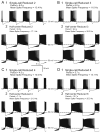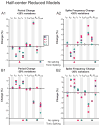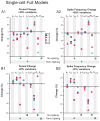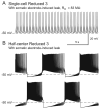Endogenous and half-center bursting in morphologically inspired models of leech heart interneurons
- PMID: 16760353
- PMCID: PMC2902779
- DOI: 10.1152/jn.00025.2006
Endogenous and half-center bursting in morphologically inspired models of leech heart interneurons
Abstract
Based on a detailed morphology "Full Model" of a leech heart interneuron, we previously developed a computationally efficient, morphologically inspired "Reduced Model" to expedite tuning the model to produce endogenous bursting and alternating bursting when configured as a half-center oscillator (paired with reciprocally inhibitory synapses). To find conductance density distributions that produce endogenous bursting, we implemented a genetic algorithm automated parameter search. With multiple searches, we found eight parameter sets that produced endogenous bursting in the Reduced Model. When these parameter sets were applied to the Full Model, all produced endogenous bursting, although when the simulation time was extended from 80 to 300 s, only four parameter sets produced sustained bursting in the Reduced Models. All parameter sets produced alternating half-center bursting in the Reduced and Full Models throughout the entire 300 s. When conductance amplitudes were systematically varied for each of the four sustained burster sets, the effects on bursting activity differed, both for the same parameter set in the Reduced and Full Models and for different parameter sets with the same level of morphological detail. This implies that morphological detail can affect burst activity and that these parameter sets may represent different mechanisms for burst generation and/or regulation. We also tested the models with parameter variations that correspond to experimental manipulations. We conclude that, whereas similar output can be achieved with multiple different parameter sets, perturbations such as conductance variations can highlight differences. Additionally, this work demonstrates both the utility and limitations of using simplified models to represent more morphologically accurate models.
Figures










References
-
- Bekkers JM. Distribution of slow AHP channels on hippocampal CA1 pyramidal neurons. J Neurophysiol. 2000;83:1756–1759. - PubMed
-
- Calabrese RL, Hill AA, van Hooser SD. Realistic Modeling of Small Neuronal Circuits. In: De Schutter E, editor. Computational Neuroscience: Realistic Modeling for Experimentalists. Boca Raton: CRC Press; 2001. pp. 259–288.
-
- Catarsi S, Brunelli M. Serotonin depresses the after-hyperpolarization through the inhibition of the Na+/K+ electrogenic pump in T sensory neurones of the leech. J Exp Biol. 1991;155:261–273. - PubMed
Publication types
MeSH terms
Substances
Grants and funding
LinkOut - more resources
Full Text Sources

